It looks like you've stumbled upon a page meant to be read by our code instead of viewed directly. You're probably looking for this page.
Feast Your Senses
Mouth-Wateringly Beautiful Cookbooks
Here’s a crop of snappy new cookbooks that are bright with healthy flavors and tuned in to seasonal availability of highquality, locally grown and crafted ingredients. Spurning industrialized agriculture and food production, these contemporary projects respond to greater interest in more mindful eating, in plantbased and natural foods diets, and in growing, harvesting, and making one’s own ingredients.
And these authors and publishers devote attention to the visual appeal of their books, as well. Gone are the days of the imageless compilation of recipes and kitchen advice; instead, these cookbooks burst with interesting graphic design, elegant photography, and passionate advocacy of environmentally sustainable, artisanal, and unprocessed foods.
So, go grab a cup of iced herb tea, slap a napkin around your neck (you’ll drool), and curl up in a comfy spot to feast your senses on this bouquet of temptations.
The Power of Pulses
Saving the World with Peas, Beans, Chickpeas, Favas & Lentils
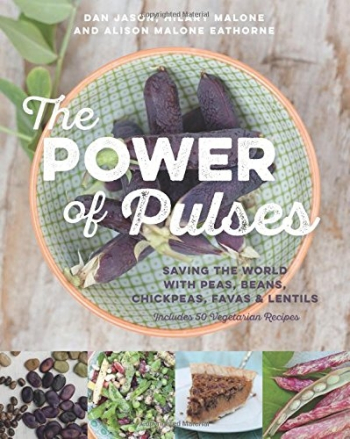
Alison Malone Eathorne
Hilary Malone
Dan Jason
Douglas & McIntyre
Softcover $24.95 (240pp)
978-1-77162-102-1
Buy: Local Bookstore (Bookshop), Amazon
As much a garden book as it is a book to cook from, The Power of Pulses is a lively collaboration between seedsman Dan Jason and foodie siblings Hilary Malone and Alison Malone Eathorne. Published in celebration of the United Nation’s designation of 2016 as the International Year of the Pulses, this book offers many glorious and persuasive reasons to grow, buy, and eat more of these super vegetables, which are surprisingly easy to cultivate, harvest, and store. Crystal-clear prose reveals that pulses self-fertilize and even enrich the soil after they are grown, unlike the majority of other crops. As fuel for the body, not only are they creamy, filling and delicious, they are dense with fiber, protein and other nutrients.
The authors spike their exhortations to use more of these legumes with gorgeous photomosaics of dried beans and peas and pulse-porn photography of them curling luxuriantly on the vine. Much of the text is devoted to discussion of how to grow the different kinds of pulses, particularly the strikingly colorful heirloom varieties. Subsequent chapters on methods for drying and storing crops and saving seeds finish with a crescendo of fifty innovative vegetarian recipes, from Lentil and Mushroom Pate to Mac and Peas. Pulses even star in desserts, like the toothsome-sounding Black Bean Brownies with Espresso Ganache.
This volume will be most useful to kitchen gardeners, especially those who enjoy experimenting with new vegetables each season, but even folks who prefer to buy their produce at the market will learn scads about how to incorporate more of these alluring plant dynamos in their daily meals. North American farmers have been growing many kinds of pulses, primarily for export, but with persuasive cookbooks like this one and the UN’s promotions, there will undoubtedly be fewer pulses sent overseas and more of us chowing down on them on the homefront.
RACHEL JAGARESKI (May 27, 2016)
The Help Yourself Cookbook for Kids
60+ Easy Plant-Based Recipes Kids Can Make to Stay Healthy and Save the World
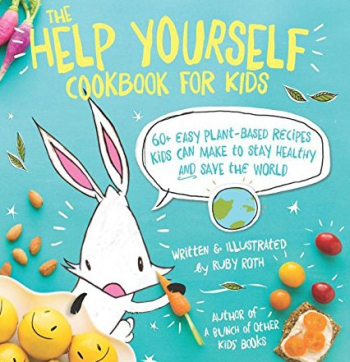
Ruby Roth
Andrews McMeel Publishing
Softcover $19.99 (144pp)
978-1-4494-7187-3
Buy: Local Bookstore (Bookshop), Amazon
Author-illustrator Ruby Roth’s students and colleagues must really miss the former elementary art school teacher. The Help Yourself Cookbook for Kids crackles with dynamic images and text that convey her impressive talent for breaking down important messages about healthy eating and environmental issues with passion and a rainbow palette of ingredients. The tone is upbeat and encourages young readers to tackle recipes themselves rather than wait for someone else to whip up some tuck.
And what color-drenched and enticingly-named concoctions these are: Party in a Cup (Fruit and Yogurt), Tomato Tornado (Tomato Soup), Hungry Caterpillar Nori Rolls and Puff Love (Toasted Mochi). All of the sixty-plus easy-to-make recipes are vegan and lean toward portable snacks, shakes, and smaller meals, though there are some recipes that are more complicated and are tagged with “Adult Alerts” when the cooking involves knives or heat. The spiral bound format and coated paper stock are extra thoughtful touches that make it easy to cook from its pages on a kitchen counter and wipe up spatters.
Roth’s illustrations are a combination of color photographs, short bursts of text in playful fonts and cartoony animals, fruits and vegetables that cavort in between. Each recipe has a unique one- or two-page layout and background color, boosting its kid appeal. And like the talented educator that she continues to be, Roth integrates sidebar messages about the nutritional and global benefits of a plant-based diet. It’s a complete package that delightfully beats a path to the kitchen, illustrated with vivacity and humor.
RACHEL JAGARESKI (May 27, 2016)
Dining at the Ravens
Over 150 Nourishing Vegan Recipes from the Stanford Inn by the Sea
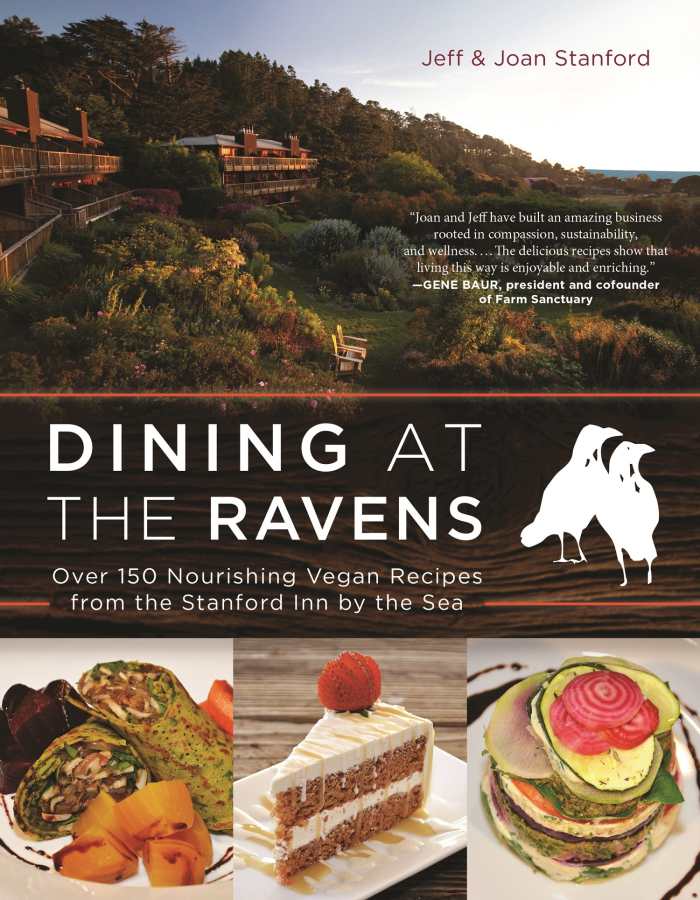
Joan Stanford
Jeff Stanford
BenBella Books
Softcover $19.95 (304pp)
978-1-941631-65-2
Buy: Amazon
Married innkeepers Joan and Jeff Stanford gradually built a vegan pleasure dome at their California home, creating America’s only vegan resort, complete with organic farm and restaurant, The Ravens. The Stanfords’ philosophy evolved slowly since they started caretaking the seaside inn in the 1970s, changing from vegetarianism to veganism, amidst raising a family and layering on additional edible landscaping and renovation projects. Today, The Ravens is renowned as a fine dining and eco-friendly destination, though the many imaginative recipes that fit this high-end aesthetic easily translate into recipes one can make in a home kitchen.
Tucked among over 150 recipes for luxuriously healthy baked goods, soups, appetizers, main dishes, and more are descriptions of the couple’s food philosophy, gardening advice and cooking tips. Recipe inspiration comes from various culinary traditions, including India, Latin America, Italy, and the American Southwest; the cookbook also shines a spotlight on some unusual ingredients which grow abundantly around their Mendocino coastal location, including sea palm, minutina, huizontle, and a variety of greens. As it comes from a resort, there are naturally a lot of recipes in the book for morning meals, but this section is not full of standard fare like pancakes and eggs, but sustaining plates of vegetable scrambles, enchiladas, chilaquiles, and The Ravens’ bestseller, Citrus Polenta with Braised Garden Greens, slathered with Creamy Toasted Cashew Sauce.
While vegan cooking is rooted in the earth, this is a sophisticated cookbook. All recipes are beautifully photographed, with stylish and innovative presentations. Whether it’s the riotously striped column of color of the Salad Napoleon, or the delicately browned and fragile Beggar’s Purse stuffed with mushrooms, arugula and tofu, cooking from this book promises to be both a visual and gustatory delight.
RACHEL JAGARESKI (May 27, 2016)
The Farmette Cookbook
Recipes and Adventures from My Life on an Irish Farm
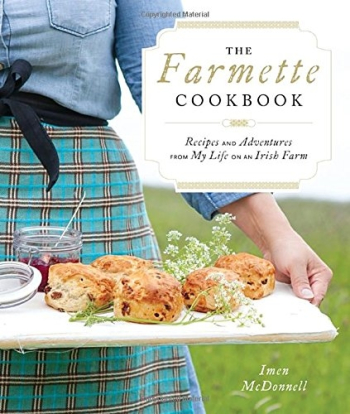
Imen McDonnell
Roost
Hardcover $35.00 (384pp)
978-1-61180-204-7
Buy: Amazon
Omnivores are not left out of the new crop of cookbooks, and the focus in Farmette is on growing or buying the best quality ingredients from local sources. Author Imen McDonnell was a confirmed American urbanite before meeting her future husband, scion of a family dairy farm in County Limerick, Ireland. The engaging chronicle of her transformation into the Farmette is strewn like dried fruit in a Halloween Barmbrack among the recipes and the creamy photographs of food and farm. She’s a great storyteller and infuses this memoir-laden cookbook with tales of how she fell headlong in love with a man, a family, a farm, and a country.
McDonnell was guided into Irish country cooking by her late mother-in-law, Peggy, and there are generous helpings of her slightly tweaked, traditional recipes for holiday favorites, comforting meals for drizzly days, and baked goods. The author champions the splendid local fish, potato varieties, meats, and berries, but leads off with a rich introduction to fresh dairy products, including directions for making butter, a number of cheeses, Milk Jam, and even homemade Irish Cream.
The author developed her own niche on the family farm by cultivating a large kitchen garden and scouring the farm and countryside for wild edibles. Foraging treks with her young son and her flair for incorporating American and other ethnic influences are clearly evident in such innovative recipes for Lavender Sloe Gin Jellies and Wild Garlic and Soft Irish Cheese Tamales. Through it all, she interprets Irish farmhouse cooking for others, from a tour of the Irish pantry, to revelations about how the Irish really celebrate St. Patrick’s Day (hint: it’s not with corned beef), to her helpful scullery notes at the end of each recipe.
RACHEL JAGARESKI (May 27, 2016)
Fresh Fish
A Fearless Guide to Grilling, Shucking, Searing, Poaching, and Roasting Seafood
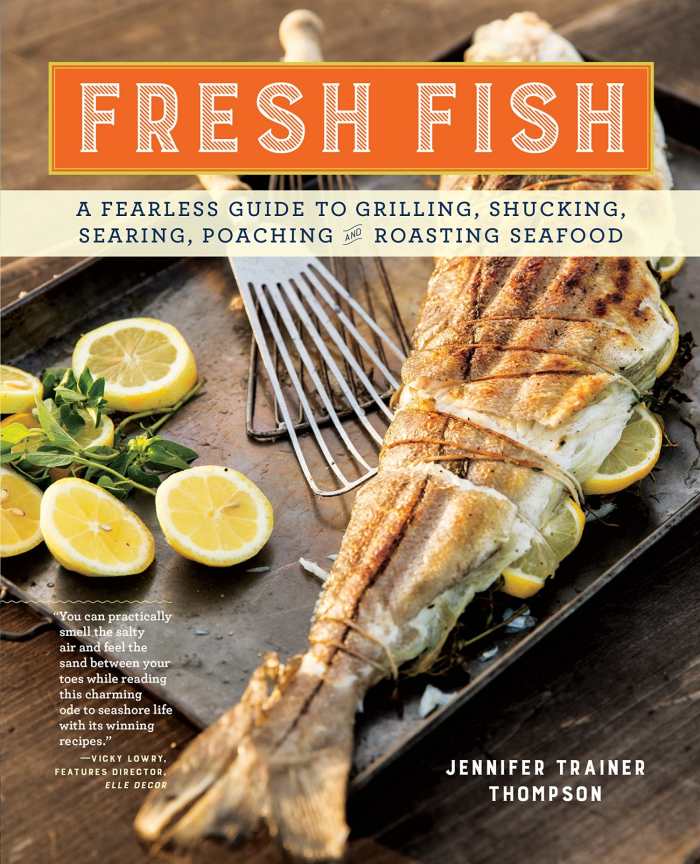
Jennifer Trainer Thompson
Storey Publishing
Hardcover $29.95 (352pp)
978-1-61212-808-5
Buy: Amazon
New England cuisine and its piscine bounty are the stars of this outdoorsy new cookbook by acclaimed cookbook author Jennifer Trainer Thompson. At least half of the profusion of color photographs are shot by the shore, and one can almost feel and smell the salt spray of the ocean while flipping through the gorgeous compositions.
Freshness is the mantra of this cookbook, and Thompson provides expert advice about how to select and prep the best and tastiest fish and shellfish at the market, even if one lives thousands of miles from the Atlantic. Her recipes focus on ways to best capture the delicate flavors and textures of the fish in question, whether it’s wood roasting for a whole striped bass, assembling a traditional clambake at the beach, or tucking crabmeat into a Puerto Rican style empanada. A generous dollop of recipes for side dishes, desserts and cocktails round out the fishy feasts. The recipes are simple and elegant and rely on the sweet, succulent, and briny flavors of the fish themselves and execution of proper preparation and cooking techniques.
The book reflects the resurgent interest in regional American food culture with many sidebars and photo essays about New England fishing communities, the importance of cod, oysters, and clams in the local history, economy, and culture, and sustainable seafood practices. These visually and literarily interesting counterpoints spice up the standard cookbook format of introduction and recipe. The author zips things up further with fun quotes, interviews, and personal memories of many summers spent with her “Swamp Yankee” relatives at the Massachusetts shore.
RACHEL JAGARESKI (May 27, 2016)
Chickpea Flour Does It All
Gluten-Free, Dairy-Free, Vegetarian Recipes for Every Taste and Season

Lindsey S. Love
The Experiment
Softcover $19.95 (240pp)
978-1-61519-304-2
Buy: Local Bookstore (Bookshop), Amazon
A decade ago, most cooks would only have one bag of flour in their pantry. It would be white wheat flour and it would feature heavily in all baking and much of one’s other cooking. Nowadays, with a greater focus on food allergies, healthier carbohydrates, and whole foods, kitchen cooks are as likely to reach for flours made from other grains, seeds, and nuts. Popular blogger Lindsey S. Love (of Dolly and Oatmeal fame) makes a convincing case for stocking chickpea flour as a cupboard staple. It is a versatile, more nutritious, and fiber-rich flour that she showcases in this creative cookbook full of international flavors.
Her go-to ingredient is a mainstay of Indian cuisine—where it is more commonly referred to as besan or gram flour—and while there are Indian-inspired recipes in the mix, Love just as easily tempts with dishes grounded in the foodways of Egypt, Vietnam, Sicily, Japan, and the American South. While one might associate the chickpea with savory foods, its flour adds richness and adapts readily to sweet treats like Cherry Dutch Baby, Fig and Hazelnut Clafouti, and Chocolate Olive Oil Cakes.
Thoughtfully organized for seasonal cooking and eating, this volume bursts with chic and unusual twists on familiar dishes, like Chickpea Noodles paired with Miso-Kale Pesto, or that nostalgic campfire favorite, s’mores, made for adult palates with homemade graham crackers, high quality chocolate, and fresh strawberries.
Love’s debut cookbook shines with her luminous food photography. The reader’s quandary will be to decide which of these sublime chickpea recipes to cook up first.
RACHEL JAGARESKI (May 27, 2016)
The Farmers Market Cookbook
The Ultimate Guide to Enjoying Fresh, Local, Seasonal Produce
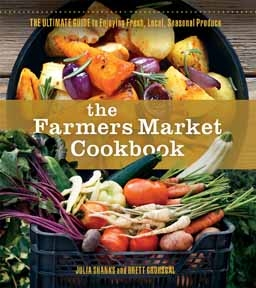
Julia Shanks
Brett Grohsgal
New Society Publishers
Softcover $29.95 (336pp)
978-0-86571-822-7
Buy: Local Bookstore (Bookshop), Amazon
The popularity of local farmers’ markets and community-supported agriculture (CSA) initiatives often involves a common question: what to do with an uncommon or abundant supply of—insert fruit/vegetable/herb of choice here—and how should it be stored? Whether it is tomato or kohlrabi season, it’s easy to get overwhelmed by unfamiliar vegetables or an overabundance of seasonal bounty that seduces at the markets or shows up in a CSA box and then drifts over the kitchen counters. This wonderfully organized book by culinary instructor Julia Shanks and organic farmer Brett Grohsgal shows how to transform it all into delicious, nutritious meals.
The cookbook describes many varieties of produce and suggests general preparation methods, before launching into a detailed chapter about storage, canning, and freezing options. Shanks and Grohsgal offer many examples of how to easily and economically prep seasonal harvests for later use. Learn how to stock frozen cubes of snipped fresh herbs to pop out later as snow piles on the windowsills, or how to keep a supply of onions or potatoes in the larder for up to 20 weeks, smartly purchased when the harvest is most bountiful and cheap.
Recipes are grouped by meal type and many are noted as being gluten-free, vegan, or vegetarian. Most of the neatly explained 200+ recipes are riffs on culinary standards, but the authors, both former restaurant chefs, have plenty of zippy, innovative dishes to try. How about Turnip Bruschetta, Coconut-Sorrel Soup, Japanese Nuka Bran Pickles, or Sweet Potato Ice Cream? (Yes, please!) The index by ingredients makes finding recipes for a particular ingredient a snap, whether one is confounded by celeriac or baffled by a big bunch of broccoli raab.
RACHEL JAGARESKI (May 27, 2016)
In the Footsteps of Nonna
Recipes and Ramblings in Southern Italy and Sicily
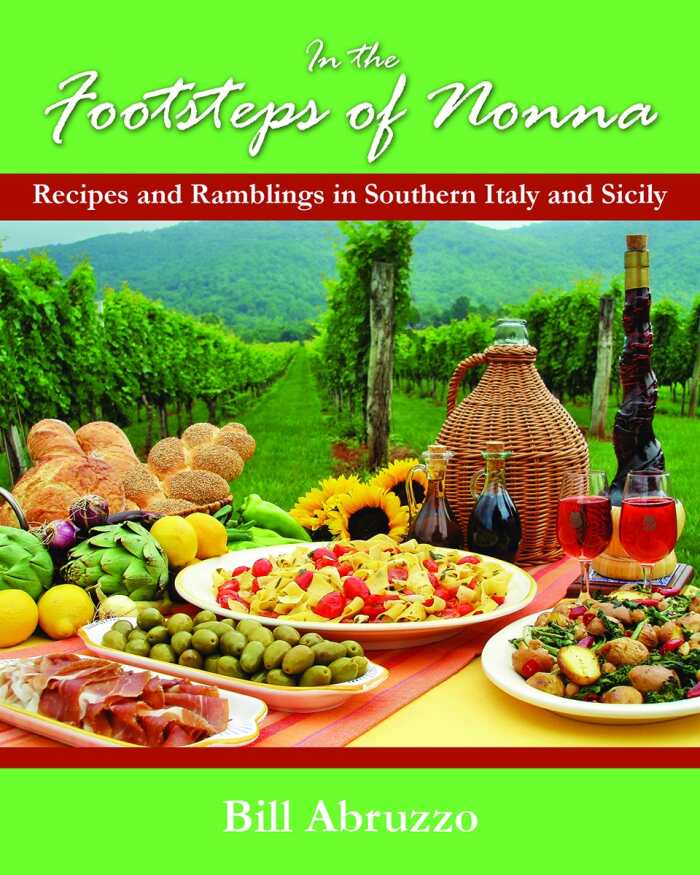
Bill Abruzzo
Pelican Publishing Company
Hardcover $28.95 (288pp)
978-1-4556-2162-0
Buy: Amazon
Passion for his Italian heritage and its food routed Bill Abruzzo out of his lawyer’s suits and into chef’s whites. He has traveled widely and often to the Italian peninsula, retracing the youthful foodcentric vacations he shared with his grandmother with his adult palate and eyes, and exploring new regions and products. This book is the first planned in his Recipes and Ramblings series, and in it he takes readers on an exuberant tour of the regions of Calabria, Apulia, Abruzzo, Campania, Lazio, Molise, Basilicata, and Sicily.
Abruzzo’s energetic descriptions of the local food markets, fishing villages, street vendors and agriturismi (farmhouse resorts) introduce each chapter and recipe. He shares his authoritative knowledge about regional culinary history and techniques with vivid imagery and anecdotes, which are further illustrated with his many color photographs of each dish and of Italian scenes.
The book is a great combination of informal travelogue and top-notch recipe instruction. American home cooks who have not yet experimented with salt cod, octopus, rabbit, tripe, or other infrequently employed foods will be lured by Abruzzo’s patient, uncomplicated instruction and tempting descriptions. He’s learned from a large circle of friends and local food producers throughout southern Italy and refreshingly always credits his mentors.
The author is not only a professional chef, but operates a specialty food business from his small Virginia farm. Herbs and Italian vegetables feature prominently in this cookbook, and his brimming enthusiasm for the freshest ingredients, and for making breads, pastas, and soups from scratch, will have readers running for their rolling pins.
RACHEL JAGARESKI (May 27, 2016)
Rachel Jagareski
